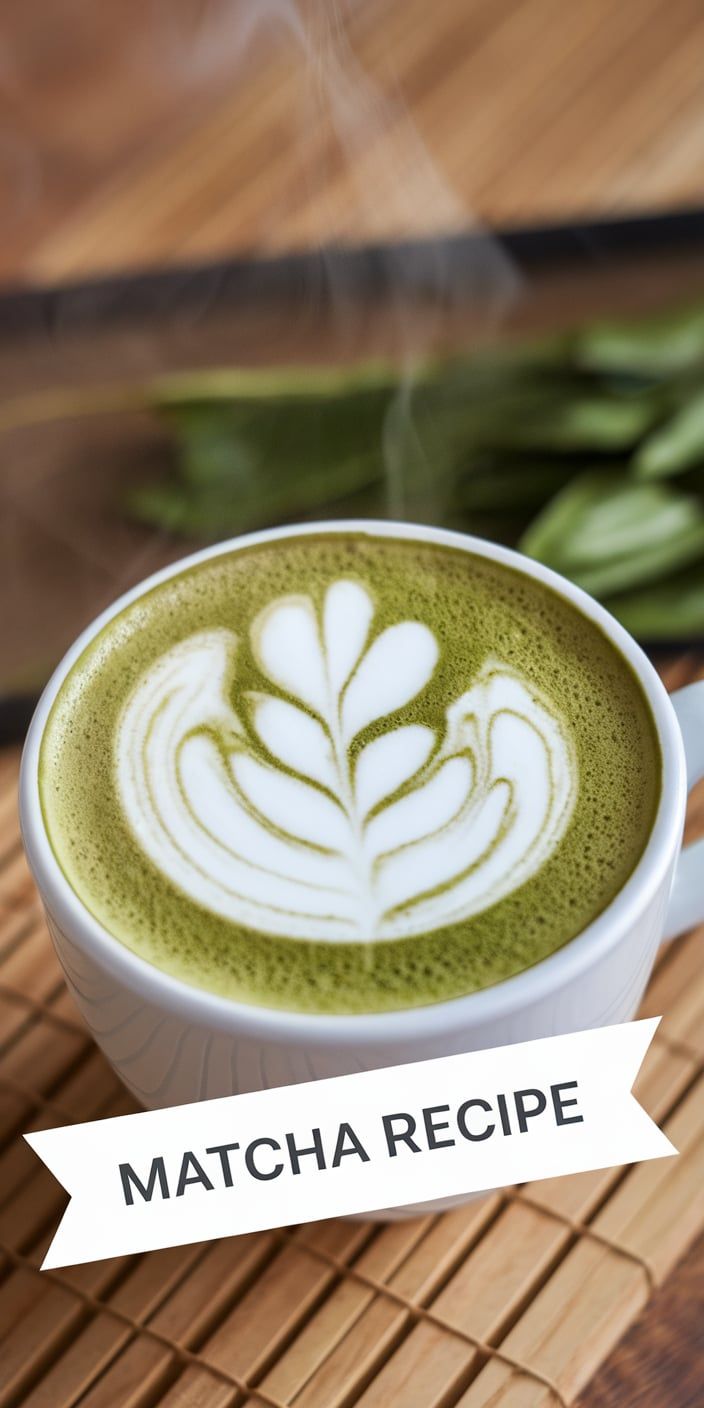Welcome to your ultimate guide for crafting an incredible matcha recipe that brings authentic Japanese tea culture right into your kitchen. As a passionate tea enthusiast, I’ve spent years perfecting the art of making the perfect cup of green tea using traditional matcha techniques.
Preparing matcha isn’t just about mixing powder and water—it’s a culinary experience that connects you with centuries of Japanese tradition. This comprehensive guide will walk you through everything you need to know about creating a delicious matcha green tea that’s both vibrant and smooth.
Whether you’re a curious beginner or a seasoned tea lover, my step-by-step approach will help you master the intricate process of brewing an exceptional matcha. From selecting the right ingredients to understanding precise whisking techniques, you’ll soon be creating café-quality matcha in the comfort of your own home.
Get ready to transform your tea routine and discover why matcha has become a beloved beverage worldwide. Let’s dive into the wonderful world of this remarkable green tea!

What is Matcha and Its Traditional Japanese Origins
Matcha is a unique and vibrant green tea with deep roots in Japanese culture. As a traditional matcha enthusiast, I’ve discovered the fascinating story behind this extraordinary beverage that goes far beyond a simple drink. Originating in Japan, matcha has been an integral part of the Japanese tea ceremony for centuries, representing a profound cultural and spiritual practice.
The Japanese tea ceremony transforms matcha preparation into an art form, carefully cultivating and processing green tea leaves with meticulous attention to detail. Unlike other teas, matcha is made from specially grown and processed green tea leaves that are ground into a fine powder.
The Ancient Art of Matcha Preparation
Preparing traditional matcha requires specialized skills and specific tools. The process involves several key steps:
- Selecting high-quality tea leaves
- Carefully shading tea plants before harvest
- Hand-picking the youngest, most tender leaves
- Stone-grinding leaves into a fine powder
Different Grades of Matcha Powder
Matcha grades vary significantly, each with unique characteristics and uses. Understanding these differences helps select the right matcha for your needs.
| Matcha Grade | Typical Use | Quality Indicator |
|---|---|---|
| Ceremonial Grade | Traditional Tea Ceremony | Highest Quality |
| Premium Grade | Drinking | High Quality |
| Culinary Grade | Cooking & Baking | Lower Quality |
Health Benefits and Nutritional Value
Matcha’s health benefits make it a true superfood. Packed with antioxidants, vitamins, and minerals, matcha offers numerous wellness advantages:
- Boosts metabolism
- Enhances mental clarity
- Supports immune system
- Provides sustained energy
By understanding the rich history and nuanced preparation of matcha, you’ll develop a deeper appreciation for this remarkable beverage that bridges tradition and modern wellness.
Essential Tools and Equipment for Matcha Making
Preparing authentic matcha requires specific tea ceremony equipment that transforms an ordinary drink into a remarkable experience. When I first started exploring matcha, I discovered that each tool plays a crucial role in creating the perfect cup.
- Matcha Whisk (Chasen): A delicate bamboo whisk with multiple thin prongs designed to break up matcha powder and create a smooth, frothy texture
- Matcha Bowl (Chawan): A wide ceramic bowl that allows proper whisking and showcases the vibrant green color of matcha
- Bamboo Scoop (Chashaku): A traditional measuring tool for precisely portioning matcha powder
- Fine Mesh Strainer: Helps remove any clumps from the matcha powder before whisking
Investing in quality tea ceremony equipment makes a significant difference in your matcha preparation. The matcha whisk, in particular, is essential for achieving that signature smooth and creamy consistency. Traditional Japanese craftsmen carefully create these whisks from a single piece of bamboo, ensuring durability and optimal performance.
When selecting your matcha tools, focus on authenticity and craftsmanship. Ceramic bowls from regions like Kyoto and hand-carved bamboo whisks provide the most genuine matcha experience. Remember, these tools are not just utensils but an integral part of the centuries-old Japanese tea tradition.
The Perfect Matcha Recipe for Beginners
Learning how to make matcha can seem intimidating, but with the right guidance, you’ll quickly master this traditional Japanese art of tea preparation. I’ll walk you through a simple matcha recipe that will help you create a delicious and authentic beverage right in your own kitchen.
Matcha preparation requires precision and care. Before diving into the recipe, gather these essential ingredients:
- 1 teaspoon high-quality matcha powder
- 2 ounces hot water (not boiling)
- A bamboo whisk (chasen)
- A ceramic tea bowl (chawan)
Measuring Your Ingredients
Accurate measurement is crucial when making matcha. Use a precise kitchen scale or measuring spoon to ensure the perfect ratio. I recommend using about 1 teaspoon of matcha powder for every 2 ounces of water. Sift the matcha powder through a fine mesh strainer to remove any clumps and ensure a smooth texture.
Water Temperature Guidelines
Water temperature plays a critical role in matcha preparation. Boiling water will burn the delicate matcha powder, creating a bitter taste. Heat water to approximately 175°F (80°C) for the best flavor profile. Let the water cool for a minute after boiling to reach the ideal temperature.
Whisking Techniques for Smooth Results
Whisking is an art form in how to make matcha. Start by adding the sifted matcha powder to your bowl. Pour a small amount of hot water and use your bamboo whisk in a rapid “W” motion. Whisk vigorously but gently to create a smooth, frothy consistency without any lumps. The goal is to create a light, creamy texture that showcases the vibrant green color of your matcha.
Common Mistakes to Avoid When Preparing Matcha
Brewing the perfect cup of matcha can be tricky for beginners. I’ve discovered several common matcha mistakes that can impact the taste and quality of your drink. Let me share some essential matcha tips to help you troubleshoot your preparation process.
One of the most critical aspects of matcha preparation is understanding potential pitfalls. Here are the key troubleshooting points for matcha enthusiasts:
- Water Temperature: Using boiling water can burn the delicate matcha powder, creating a bitter taste
- Storage Conditions: Exposing matcha to light and air can rapidly degrade its quality and flavor
- Whisking Technique: Improper whisking leads to clumpy, uneven matcha with poor texture
- Powder Quality: Selecting low-grade matcha can significantly impact the overall drinking experience
To help you navigate these challenges, I’ve created a quick reference guide for matcha mistakes and their solutions:
| Matcha Mistake | Solution |
|---|---|
| Bitter Taste | Use water around 175°F (80°C), not boiling |
| Lumpy Texture | Sift powder before whisking, use proper bamboo whisk |
| Stale Flavor | Store in airtight container, away from light and heat |
By paying attention to these matcha tips, you’ll dramatically improve your brewing skills and enjoy a more authentic Japanese tea experience.
Creative Variations of Traditional Matcha Recipe
After mastering the basic matcha preparation, it’s time to explore exciting matcha variations that will transform your drinking experience. I’ll guide you through delightful ways to enjoy this versatile green tea powder beyond traditional brewing methods.
The world of matcha offers countless delicious possibilities for creating unique and refreshing beverages. Whether you’re craving something creamy, sweet, or chilled, these matcha variations will expand your culinary horizons.
Crafting Delicious Matcha Latte Recipes
A matcha latte recipe is perfect for those seeking a smooth, creamy alternative to traditional matcha. You can create this drink using:
- Dairy milk (whole, skim, or lactose-free)
- Plant-based milks like almond or oat
- Your preferred sweetener (honey, maple syrup)
Refreshing Iced Matcha Preparations
Iced matcha drinks are ideal for warm days. My favorite method involves shaking matcha with cold water and ice, creating a crisp and invigorating beverage that’s both cooling and energizing.
Sweet Matcha Drink Innovations
Natural sweeteners can elevate your matcha experience. I recommend experimenting with:
- Agave nectar
- Stevia
- Monk fruit sweetener
These options add sweetness without overwhelming the delicate matcha flavor, allowing you to customize your drink to perfection.
Storing and Preserving Your Matcha Powder
Protecting your matcha powder’s quality is crucial for maintaining its vibrant flavor and nutritional benefits. I’ll share expert tips on matcha storage that will help you preserve its freshness and ensure you get the most out of every purchase.
When it comes to preserving matcha, the key is to shield it from three primary enemies: light, heat, and moisture. I recommend storing your matcha powder in an opaque, airtight container that blocks out harmful light and prevents air exposure.
- Choose ceramic or tin containers with tight-fitting lids
- Store in a cool, dark place like a pantry or cupboard
- Keep away from direct sunlight and heat sources
- Avoid storing near spices or strong-smelling ingredients
Matcha freshness can be significantly extended by refrigeration. If you live in a warm climate or want to preserve your matcha for longer periods, consider storing it in the refrigerator. Just ensure the container is completely sealed to prevent moisture absorption.
Once opened, try to consume your matcha powder within 4-6 weeks for optimal taste and nutritional potency. Always use a clean, dry spoon when measuring to prevent contamination and maintain the powder’s pristine condition.
Pairing Your Matcha with Traditional Japanese Sweets
When exploring the world of matcha pairings, traditional Japanese sweets called wagashi offer an exquisite culinary experience. These delicate confections are meticulously crafted to balance the robust, slightly bitter taste of matcha tea. I’ve discovered that selecting the right wagashi can transform your tea ritual into a sensory journey through Japanese culinary traditions.
My favorite matcha pairings include wagashi like mochi, daifuku, and yokan. Each sweet brings a unique texture and flavor profile that complements the green tea’s earthy notes. Soft, chewy mochi with its subtle sweetness provides a perfect counterpoint to matcha’s intense flavor. The light sugar content helps soften the tea’s robust character, creating a harmonious taste experience.
Understanding the art of Japanese sweets means appreciating their subtle nuances. Wagashi are not just desserts but an expression of seasonal changes and cultural aesthetics. When I serve matcha with these traditional treats, I’m not just sharing a beverage but inviting others to explore a rich culinary heritage. The careful balance between the tea’s intensity and the sweets’ delicate flavors creates a truly memorable moment of gastronomic delight.
If you’re new to matcha pairings, start with simple wagashi like namagashi or dorayaki. These sweets offer an approachable introduction to the complex world of Japanese confectionery. By experimenting with different combinations, you’ll develop a deeper appreciation for this centuries-old tea tradition.
